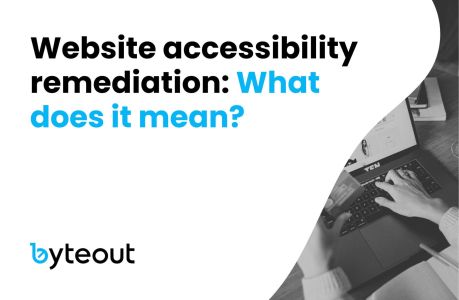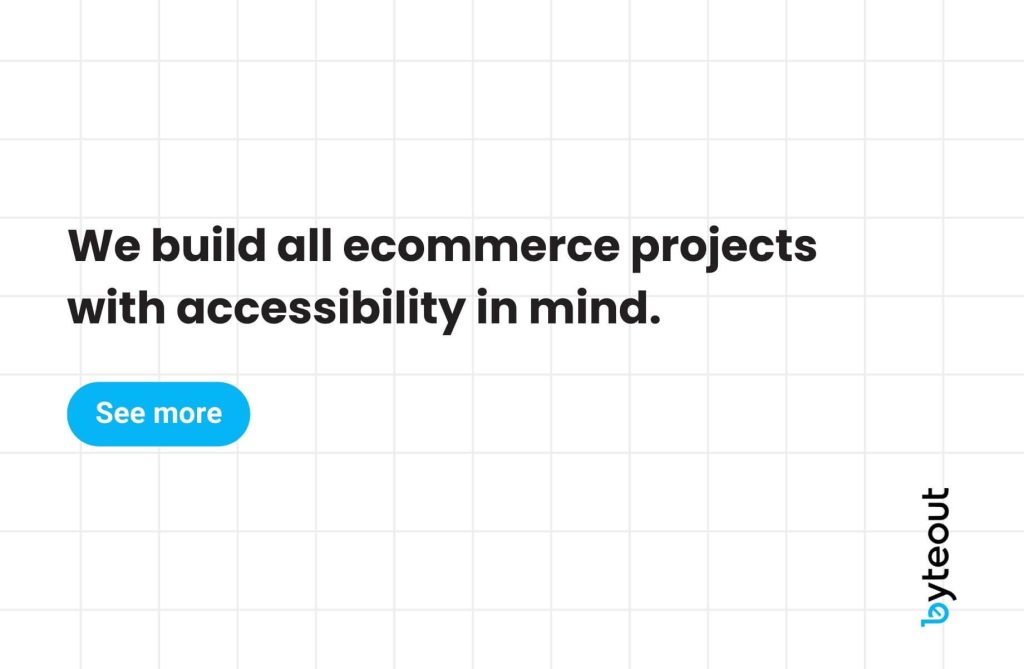
Website accessibility remediation: What does it mean?
Website accessibility remediation refers to the process of modifying a website to ensure it is accessible to all users, including those with disabilities.
The process involves identifying and fixing accessibility issues that may prevent people with various impairments (such as visual, auditory, physical, or cognitive disabilities) from using the website effectively.
Table of Contents
Why webshops need to be accessible
Webshops need to be accessible to ensure inclusivity and equal access for people with disabilities, expanding their customer base to include over 1 billion potential customers worldwide.
Accessibility improvements also improve the overall usability for all users, contributing to a better user experience. Many countries mandate digital accessibility, and non-compliance can result in lawsuits and fines.
Accessible websites often benefit from improved SEO, leading to better search rankings. Demonstrating a commitment to accessibility improves a brand’s image and reputation, showcasing social responsibility and ethical business practices.
Keeping webshops accessible also helps businesses avoid legal risks and fosters a more inclusive and user-friendly online environment.
What’s included in website accessibility remediation
Website accessibility remediation is the process of modifying a website to ensure it is usable by everyone, including individuals with disabilities. This involves identifying and fixing issues that affect accessibility.
Website accessibility remediation – general steps
Website accessibility remediation involves a series of steps to ensure that a website is accessible to all users, including those with disabilities. Let’s go briefly through these steps.
Audit and assessment
The first step in website accessibility remediation is conducting a thorough audit and assessment. This begins with automated tools that find common issues, such as missing alt text and poor color contrast.
However, since these tools can’t catch everything, experts must also perform manual testing to check navigation, interactive elements, and overall usability.
User testing with individuals who have disabilities adds valuable insights. Their feedback highlights practical challenges and usability issues that other methods might miss. Combining automated tools, manual testing, and user feedback gives a complete understanding of the website’s accessibility, which is essential for effective remediation and for creating an inclusive online environment.
👉 Get a website accessibility check here.
Compliance standards
Being compliant involves following the Web Content Accessibility Guidelines (WCAG), which outline how to make web content accessible to people with disabilities.
WCAG has three levels: A, AA, and AAA, with AA being the most commonly recommended for websites. These guidelines help make the site usable for people with visual, auditory, cognitive, and motor impairments.
Additionally, websites must meet legal requirements in their country, like the Americans with Disabilities Act (ADA) in the United States, which mandates accessibility for individuals with disabilities. This includes providing text alternatives for images, ensuring keyboard accessibility, and creating easily navigable content.
The European Accessibility Act also requires digital services to be accessible across the European Union. Complying with these standards and laws not only helps avoid legal issues but also shows a commitment to inclusivity, enhancing a business’s reputation and broadening its audience.
Content adjustments
Content adjustment process involves modifying text, images, videos, and other elements to ensure they can be used by everyone, including people with disabilities.
For images, adding alternative text (alt text) is one of the must-haves. Alt text provides a description of the image for screen readers, so visually impaired users can understand what the image depicts. This description should be concise yet informative.
Videos also need adjustments to be accessible. Providing transcripts for video content allows users with hearing impairments to read what is being said. Additionally, adding captions to videos ensures that deaf and hard-of-hearing users can follow along with the audio. Captions should be synchronized with the audio and accurately reflect the spoken content, including important non-verbal sounds.
Ensuring sufficient contrast between text and background colors makes the content easier to read for users with visual impairments, including color blindness. Using a readable font size and style, avoiding overly complex language, and organizing content with clear headings and bullet points also improve accessibility.

Structural changes
Structural changes involve adjusting the website’s structure and navigation. Proper use of HTML tags for headings, lists, and forms helps screen readers interpret the content. Headings should follow a logical order (H1, H2, H3, etc.), and lists and forms should be clearly labeled.
Keyboard accessibility is also important. All website functions should be operable via a keyboard, without needing a mouse. Clear focus indicators help users see where they are on the page.
All sites should be able to support assistive technologies, like screen readers and voice recognition software so make sure all interactive elements, like buttons and links, are properly labeled and that dynamic content updates are announced.
These structural changes make websites more inclusive and easier to navigate for everyone, improving the overall user experience.
Design improvements
Design improvements involve redesigning elements like buttons, forms, and interactive components. Buttons should be easily clickable and properly labeled with descriptive text, so users know their function. This helps users with motor impairments and those using screen readers.
Forms need clear labels and instructions for each field, making it easy for users to understand and complete them. Providing simple error messages and ensuring forms are keyboard-friendly helps all users.
Interactive components, like menus and sliders, should work correctly with screen readers and other assistive technologies. This includes making sure dynamic content updates are communicated and that users can interact using a keyboard.
Testing and validation
Testing and validation are the next steps after making accessibility adjustments to a website. This process ensures that all issues have been resolved and the site is fully accessible.
- First, automated testing tools are used to re-scan the website for any remaining issues. These tools check for compliance with accessibility standards, identifying any areas that still need improvement.
- Next, manual testing is conducted by accessibility experts. They thoroughly review the site to ensure all elements function correctly and meet accessibility guidelines. This includes checking navigation, interactive elements, and overall usability.
- User testing with people who have disabilities provide valuable feedback on their real-world experiences with the site. Their insights help identify any remaining challenges and areas for improvement that automated and manual testing might miss.
⭐ We do manual blind user testing at the beginning.
Ongoing maintenance
Regular reviews are essential to ensure ongoing compliance with accessibility standards. Automated tools can periodically scan the site for new issues, checking that all elements adhere to guidelines like the WCAG, but all new content and development should be made with accessibility in mind.
User feedback is invaluable in this process. Encouraging users, especially those with disabilities, to report any accessibility issues helps identify problems quickly. This feedback loop ensures that any new issues are addressed promptly.
- Best ecommerce agency in US – Top 10
- Ecommerce automation – work smarter
- The % split – paid ads vs SEO vs organic social in ecommerce
- How to reduce Customer Acquisition Cost (CAC)
- Ecommerce automation and Shopify Flows
Accessibility as a competitive edge
A lot of brands miss out on website accessibility. But by focusing on accessibility, you’re opening up your business to over 1 billion people with disabilities. That’s a huge, untapped market! Plus, everyone appreciates a site that’s easy to use.
When you prioritize accessibility, you’re showing customers that you care about making their experience better. And that goes a long way in building loyalty.
Conclusion
Website accessibility remediation is the solution for making your site is usable by everyone, including those with disabilities.
This whole process involves auditing the site, ensuring compliance with standards, adjusting content, making structural changes, redesigning elements, and thorough testing.
Regular maintenance is your best friend for keeping the site accessible as new content is added. This process avoids legal risks, expands your audience, improves user experience, and enhances your brand’s reputation for inclusivity.

